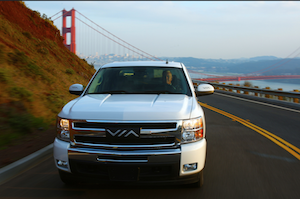At home, when you turn on the switch you expect the lights to go on. When you turn on the shower you expect hot water. We do not often get surprised because our electricity and gas utility has emergency responder crews to keep things running.
At utility giant PG&E, 190 electric trucks are now used to keep things running. If a neighborhood has a power outage, a troubled truck rolls in. A technician is lifted high in the air to look at a transformer on a pole. Auxiliaries can be run for hours powered by lithium batteries.
With traditional diesel trucks, the engine runs for hours acting as a generator to keep all these auxiliaries operating. Neighbors called to complain about the noise as vehicles can idle for up to 8 hours. If the job takes longer, legal noise restrictions stop work for the day, which was frustration if a job was one hour from completion.
But with electric trucks, there are no noise restrictions. These plug-in trucks can be used twice as many hours per day. By switching from diesel to electric, PG&E pays for the electric trucks in 2.5 years according to Dave Meisel, Director Transportation for Services for PG&E.
PG&E services 5.2 million customers that span 70,000 square miles; 13,000 vehicles are required to manage the vast territory. In 2011, PG&E bought over 10 million gallons of fuel as these fleet vehicles traveled 114,000,000 miles. The utility has 156 different types of vehicles to meet its wide-ranging needs. Different vehicles used different fuels including diesel, gasoline, natural gas, hydrogen, and electricity.
 By the end of 2012, PG&E will be using over 400 electric vehicles and another 400 hybrid vehicles from a range of vehicle makers:
By the end of 2012, PG&E will be using over 400 electric vehicles and another 400 hybrid vehicles from a range of vehicle makers:
- Altec Class 6 Trucks
- Eaton/International Bucket Truck
- Smith Electric Flatbed Truck
- Via Pickup Truck
- Navistar eStar
- Ford F450 Conversions by EVI
- Chevrolet Volt
- Toyota Prius
PG&E is expanding its fleet of electric vehicles for several reasons: fuel savings, the future potential of the EV’s, and exportable power, and vehicle maintenance savings. Instead of depending on petroleum fuel from unstable parts of the world, American utilities are increasingly making their own fuel for their own fleets. Best of all, some applications have a fast return on investment.
There are downsides for a fleet manager when buying electric vehicles: higher upfront capital expenditure, financing, charging infrastructure, range and operational challenges. For vehicles where the daily range and use is unpredictable, plug-in hybrids are prioritized over all of electric vehicles.
Vehicle-to-Grid (V2G) is Already Used by Utilities
Some of these electric trucks have up to 100 kW of electric batteries. The trucks have exportable power that can be used to run external equipment and power tools. This power can even be put onto the grid to get a neighborhood up and running faster, or during the planned replacement of a transformer.
Electric trucks already saving utilities millions in fuel, better labor utilization, and improved network reliability. In the future, these trucks will make the utilities added millions during peak hours by putting electricity on the grid rather than firing up dirty and expensive peak or plants.
Over 20 utilities and wholesalers, including SCE, Duke Energy and PJM, have already experimented with vehicle to grid (V2G). As utility fleets grow, more reserve vehicles will be part during peak hours making V2G a reality.
In the next decade V2G will expand from utility fleets to a growing part of our nations 12 million fleet vehicles. Toyota and Nissan are already providing passenger cars with vehicle to home (V2H) for emergency situations. If automakers utilities, and regulators with their warranty requirements all work together, then V2G can be widely available in the next decade.
 PG&E already has thousands of customers with electric cars. For example, my wife and I can drive the Nissan Leaf and charge it on PG&E after 10 PM. We would love to charge at night at a low rate and sell electricity to PG&E at a higher rate during peak hours. 10 years from now, there may be millions of American drivers with a similar preference.
PG&E already has thousands of customers with electric cars. For example, my wife and I can drive the Nissan Leaf and charge it on PG&E after 10 PM. We would love to charge at night at a low rate and sell electricity to PG&E at a higher rate during peak hours. 10 years from now, there may be millions of American drivers with a similar preference.
Pike Research estimates that there are nearly 11 million households globally that are currently enrolled in DR programs. With a compound annual growth rate (CAGR) of 11.6%, that number of households is forecast to more than double, to over 23.5 million, by 2018. Pike Navigant Report Summary
When we have millions of electric vehicles, utilities will better match electric generation with demand. Vehicles will charge off-peak when the most efficient plants can continue running and win-win power is most available. Electricity can be exported from vehicles and even recycled lithium batteries during peak hours.
Research reports and PG&E’s electric fleet and other exciting electric fleet initiatives are freely available from the Electric Vehicle Coalition’s FleetAnswers.
Related Articles
Power Outages, Electric Cars, Vehicle-to-Grid
SDG&E First to Charge 1,000 Electric Cars with a Smart Grid
NRG Battles for 10,000 Charge Points
Vehicle-to-Grid: Utility Giant PG&E Gets Fast ROI from 190 Electric Trucks is a post from: Clean Fleet Report


















